
编者按
联合国教科文组织、中国教育部、中国联合国教科文组织全国委员会、国家语言文字工作委员会、湖南省人民政府于2018年9月19日至20日在湖南长沙共同举办了“语言多样性对于构建人类命运共同体的作用:语言资源保护、应用和推广”国际会议(即“首届世界语言资源保护大会”),来自世界各地的参会者代表政府,国家语言文字管理部门,学术界,公共部门或私人机构,以及濒危语言、少数民族语言、土著语言、非官方语言和方言使用者宣布通过了《岳麓宣言》。
2019年1月16日,联合国教科文组织官网正式发布《保护和促进世界语言多样性岳麓宣言》,并配发新闻。
以下为联合国教科文组织官网新闻稿的中文译稿(来源于“语宝”公众号,本刊作部分修改),以及《岳麓宣言》的中文译稿和英文原稿(来源于联合国教科文组织官网)。
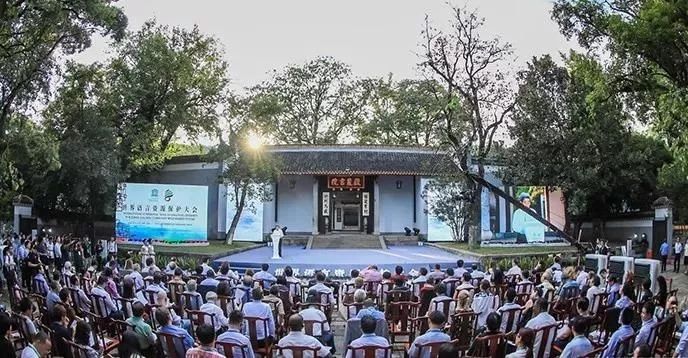
联合国教科文组织
致力于保护和促进语言多样性
“语言多样性对于构建人类命运共同体的作用:语言资源保护、应用和推广”国际会议于2018年9月在中国长沙举办。来自世界各地的参会者代表政府,国家语言文字管理部门,学术界,公共部门或私人机构,濒危语言、少数民族语言、土著语言、非官方语言以及方言使用者宣布通过《岳麓宣言》。
宣言指出,保护和促进语言多样性对于可持续发展目标的实现至关重要,有助于促进人类发展。因为保护语言多样性的本质是保障各语言使用者在教育及其他基本的公共服务、就业、健康、社会融入、参与社会决策等方面机会均等。
此外,在这次重要的国际会议上,参会者们强调了保护和促进语言多样性需要国际社会各方面积极作为、切实有效参与其中。宣言倡议联合国教科文组织及其他联合国机构应充分调动一切可利用的资源,切实承担起倡议、引领、促进、普及、保护世界语言多样性的重要职责。鼓励各成员国制定健全的语言政策和语言资源管理运营机制;鼓励国家语言文字管理部门、学术界、非政府组织、公共和私人机构以及个人通过科研、媒体、课程、艺术、文化产品和信息通信技术等多种方式保护和促进语言多样性。
最后,宣言强调保护和促进语言多样性应当与科技发展相结合。通过人工智能、信息通讯等技术推动语言文化的创造性转化、创新性发展和有效传播,积极研发语言数据采集分析工具。此举将促进联合国教科文组织“世界语言地图”项目的建设。
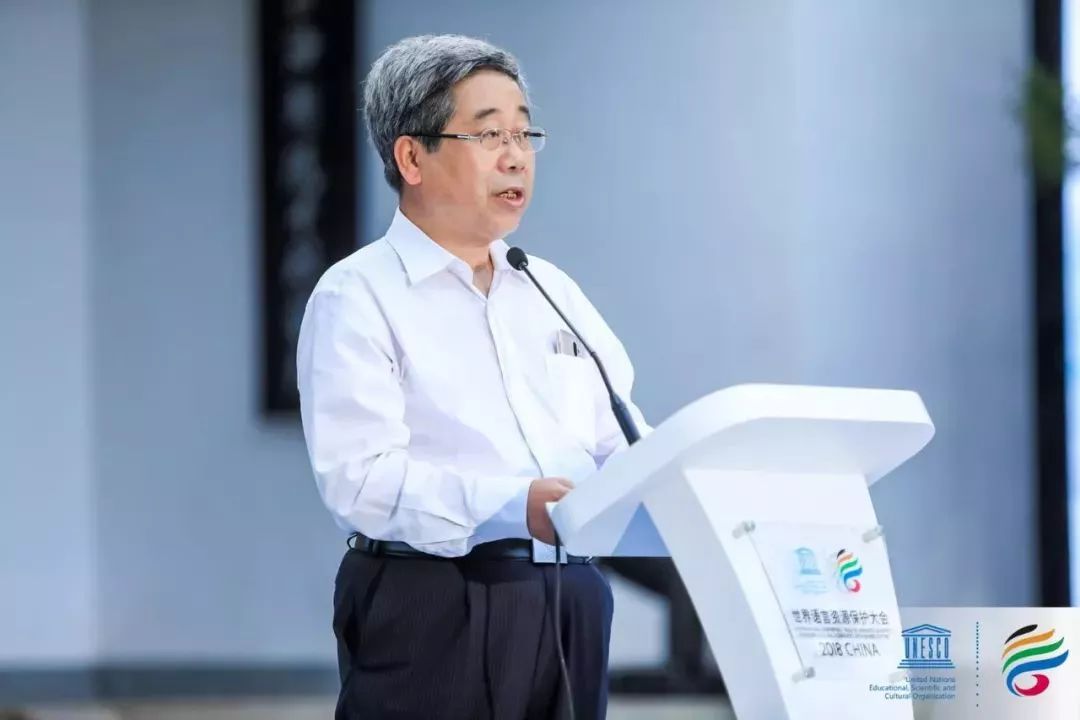
教育部部长陈宝生在世界语言资源保护大会闭幕式上讲话

闭幕式上,《岳麓宣言》起草组组长爱尔莎女士介绍宣言内容时落下了动情的泪水
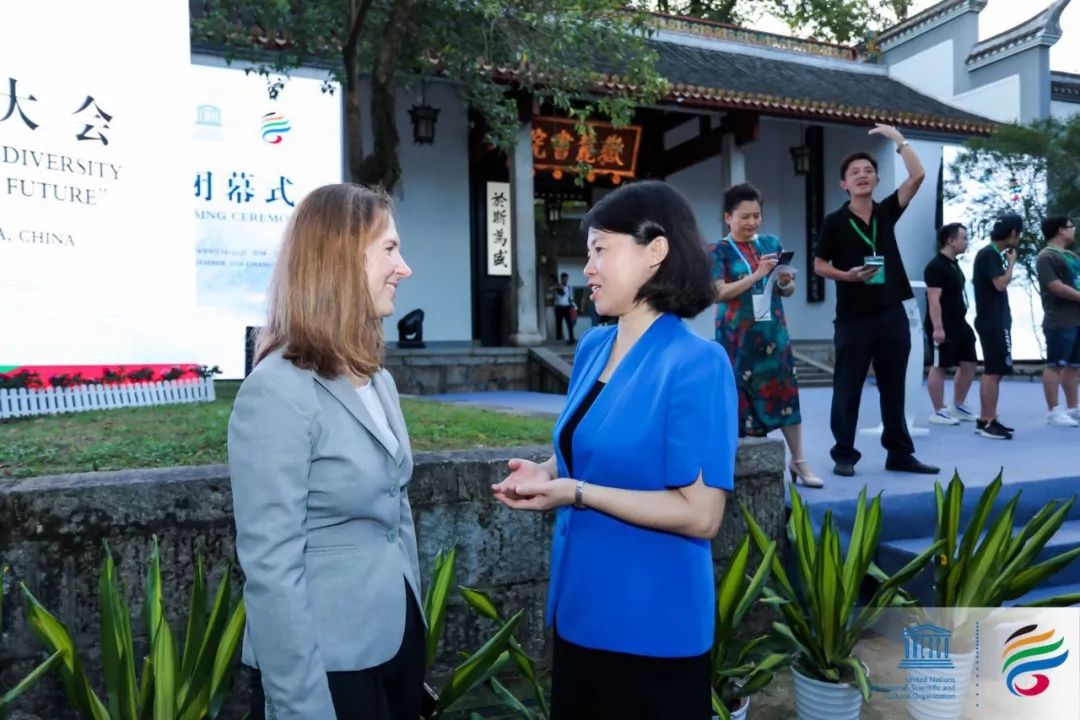
闭幕式后,教育部语信司司长田立新与UNESCO项目专家布卡伊商谈
《岳麓宣言》后续发布事宜。
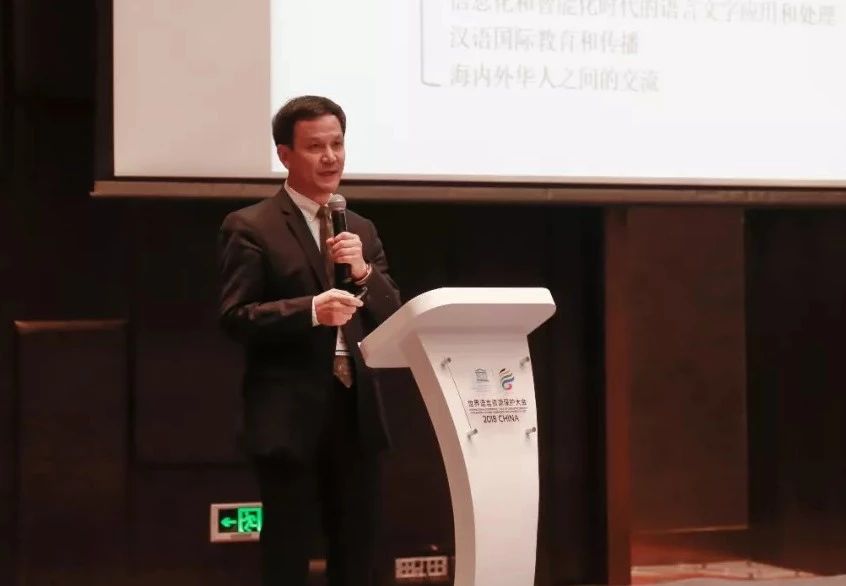
中国社会科学院语言研究所所长、时任全国汉语方言学会会长刘丹青研究员
参加了本次会议,并做了题为“差别化政策是语言保护工作的迫切要务”的发言。
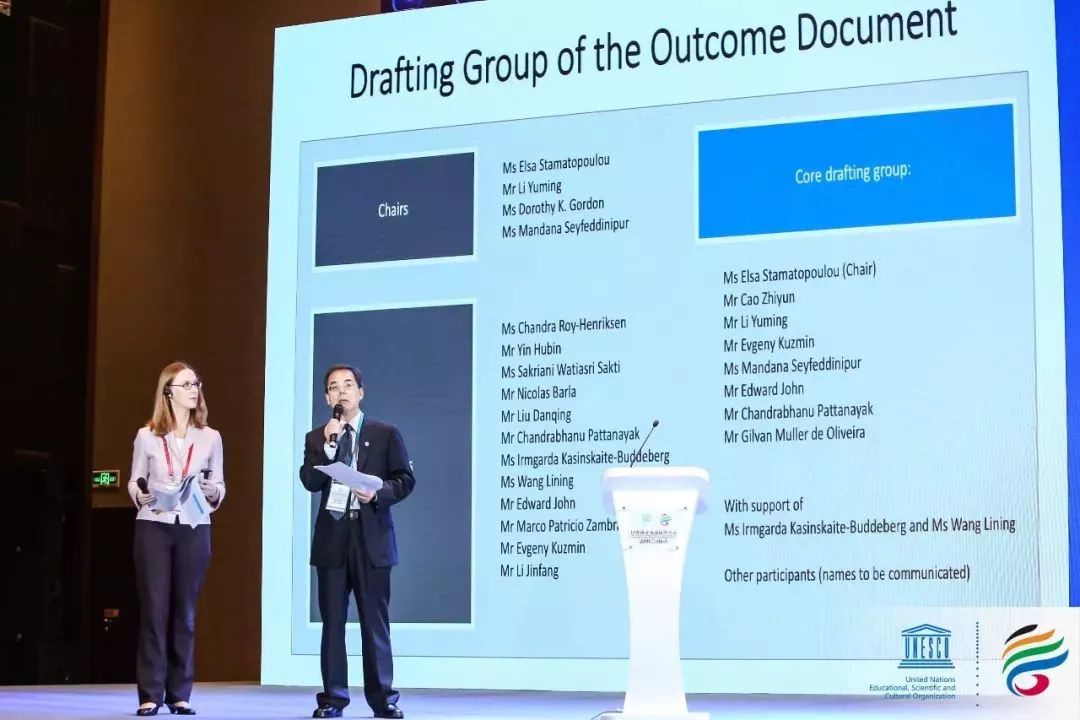
第一次全体会议上,中国语言资源保护研究中心主任曹志耘与UNESCO项目专家
布卡伊介绍《岳麓宣言》起草方案
保护和促进世界语言多样性
岳麓宣言
世界语言资源保护大会
2018年9月19–21日,中国长沙
引言
我们生活在不同语言、文化、种族、宗教和不同社会制度所组成的世界里,形成了你中有我、我中有你的命运共同体。语言是促进人类发展、对话、和解、包容与和平的重要前提之一。
人们需要通过语言与他人沟通,并且通过语言将知识、观念、信仰和传统代代相传,这对于人类的生存、自尊、幸福、发展以及和平共处必不可少。我们认识到,在代代相传的历程中,儿童时期的语言学习效果最佳。
同时,语言还是文化的基本特征之一,是记录并传承一个族群、一个地区乃至世界独特文化的主要载体,它有助于人们通过共享的行为模式、互动方式、认知结构和理解方式来交流并构建人类命运共同体。语言记录了人类千百年来积累的传统知识和实践经验。这一知识宝库促进人类发展,见证了人类改造自然和适应环境的能力。
来自世界各地的参会者代表政府,国家语言文字管理部门,学术界,文化、信息和记忆组织,公共部门或私人机构,濒危语言、少数民族语言、土著语言、非官方语言以及方言使用者,其他有关专家于2018年9月19-20日在中国长沙共同出席了世界语言资源保护大会,并且通过本宣言。本宣言:
遵守《世界人权宣言》(1948)提到的各项人权和基本自由,以及其他国际公认的法律文件。
回顾联合国教科文组织组织法序言里申明的:“战争起源于人之思想,故务需于人之思想中筑起保卫和平之屏障。”(1945年11月16日),重申联合国教科文组织是一个积极促进语言多样性和多语主义的联合国系统机构。
基于其他支持语言权利的国际人权文件,包括:《消除一切形式种族歧视国际公约》(1965)、《经济、社会及文化权利国际公约》(1966)、《公民权利和政治权利国际公约》(1966)、《儿童权利公约》(1989)、《保护所有移徙工人及其家庭成员权利国际公约》(1990)、《在民族或族裔、宗教和语言上属于少数群体的人的权利宣言》(1992)、《残疾人权利公约》(2006)、《联合国土著人民权利宣言》(2007)以及国际人权条约和其他机构在这一领域的工作。
回顾了其他国际文件,包括《世界文化多样性宣言》及其行动计划(2001)、《保护非物质文化遗产公约》(2003)、《保护和促进文化表达多样性公约》(2005);《关于普及网络空间及提倡和使用多种语言的建议书》(2003)。1
申明语言多样性政策必须首先尊重人民和社区作为语言守护者的尊严,尊重他们的权利,并就保护和促进语言多样性与他们真诚合作,探讨了为语言振兴、保护和促进所做出的努力,并获悉土著语言以及其他语言不断面临濒危困境的情况。
既考虑到语言和其承载的传统知识对于文化多样性和生物多样性极为重要,尤其在应对气候变化和环境恶化时至关重要,也考虑到拥有自己的语言是决定土著人民享有自决权的一个因素。
回顾绝大多数濒危语言是土著人民语言这一事实;也赞同联合国大会在关于“土著人民权利”的决议(编号 71/178)中表达的紧迫感,该决议宣布 2019 年为“国际本土语言年”。
重申联合国大会 2014 年 9 月 22 日第 69/2 号决议通过的《世界土著人民大会成果文件》,“全系统行动计划”2及其之后的国家行动计划;土著人民权利专家会议及其有关研究和倡议等所达成的共识;3 以及联合国土著问题常设论坛 2016 年会议(E/2016/43)的结论和倡议,其主题为:“土著语言:保护和振兴(《联合国土著人民权利宣言》第 13、14 和 16 条)”。
本宣言申明
(一)国际社会通过了强调保护语言多样性的重要国际文件以及其他政策文件;尤其是,联合国大会关于“土著民族权利”的第 71/178 号决议宣布 2019 年为“国际本土语言年”,已再次引起世界范围内对语言及其相关问题的重视。
(二)《联合国土著人民权利宣言》第 13、14、16 条进一步完善了语言权利的规范性内容。
(三)目前在特别关注保护及振兴土著人民语言文化,保护并传承濒危语言、少数民族语言、非官方语言及方言等方面已有优秀典范。
(四)近年来多个关于土著语言的国际专家会议可为此领域的工作提供借鉴。这些专门的国际研讨会汇聚了跨学科专家、政策制定者、学者以及一线工作者。联合国教科文组织制定的“2019 年国际本土语言年行动计划”也是本领域的重要文件。4
(五)“知识社会”这一概念建立在包容、开放、多样和多元等关键原则之上。文化多样性和多语主义在促进多元、公平、开放和包容的知识社会方面发挥着重要作用,也是普及教育、获取信息和实现表达自由的重要支柱。
(六)采用以人权为基础的方法,即:不歧视、人权相互依存和相互关联;关注最弱势群体;关注大众参与;基于国际人权规范的责任。
共识和倡议
共识一:保护和促进语言多样性对于可持续发展目标的实现至关重要,因此倡议:
1.保护和促进语言多样性有助于促进人类发展。保护语言多样性就是要保障各语言使用者在教育及其他基本的公共服务、就业、健康、社会融入、参与社会决策等方面机会均等,避免出现永久性文盲、失业、就医困难、受歧视和其他不公平现象,从而有利于实现消除贫困、消除饥饿和营造良好健康与福祉的人类发展目标。同时,语言多样性也是独特而古老的文化代代相传的基础。
2.保护和促进语言多样性有助于提高濒危语言、少数民族语言、土著语言、非官方语言以及方言母语者的潜力、行动力和主动性。这包括人们自儿童期便开始使用并传承母语、接受母语教育、获得互联网和其他公共空间的信息和知识,视障人士使用盲文、听障人士使用手语进行交流,增加优质教育和性别平等的机会。
3.保护和促进语言多样性有助于改善环境。维护语言多样性与理解语言赖以生存发展的自然生态环境、生物多样性、生产生活方式息息相关。在全球化的背景下,应将保护语言多样性与保护具有重大或特殊历史文化价值的城市或村落紧密结合,为保护语言多样性提供必要的环境条件和服务,探索语言多样性、环境保护与经济增长共赢的可持续发展模式。
4.保护和促进语言多样性有助于推动经济发展。语言多样性为不同的语言使用者在其教育背景、社会生活以及经济发展中争取相对平等的权利,增加濒危语言、少数民族语言、土著语言、非官方语言以及方言母语者平等和优质就业的机会,以此推动可持续的经济增长。
5.保护和促进语言多样性有助于加强社会融入、社会合作。保护语言多样性有助于减少不同母语者之间的性别与社会不平等现象,保障濒危语言、少数民族语言、土著语言、非官方语言以及方言母语者接受教育的权力,通过鼓励其参与促进文化多样性、濒危语言保护、非物质文化遗产保护的系列行动,例如口传文化、表演艺术、社会实践、宗教民俗和节庆活动等,增强弱势群体的社会融入程度和社会决策能力,以此创建更为和平、包容的社会,促进可持续发展。
共识二:保护和促进语言多样性需要国际社会各方面积极作为,切实有效参与其中,因此倡议:
6.联合国教科文组织肩负着倡议、引领、促进、普及、保护世界语言多样性的重要职责。
(1)应监测世界语言多样性现状,据此制定并落实与此相关的政策或措施;与持积极态度的政府和非政府组织、土著人民、公共和私人机构、社区和个人开展合作,支持相关合作者开展语言能力建设。
(2)联合国教科文组织应当鼓励并指导各成员国、有关学术机构及企业开展濒危语言保护工作,积极与濒危语言,包括少数民族语言、土著语言和其他弱势语言的社区建立联系。
(3)联合国教科文组织应当构建保护和促进语言多样性城市网络,探索将语言多样性作为可持续城市的重要标准之一。
(4)联合国教科文组织应当支持、鼓励和宣传以政策为导向的研究,系统全面地解决语言公正问题,并将其作为可持续发展的重要组成部分。
7.联合国和其他国际人权机构和机制有责任继续从保障人权的维度监测语言权利行使状况。这包括人权条约机构和特别程序,例如:经济、社会和文化权利委员会、儿童权利委员会、文化权利问题特别报告员和土著人民权利问题特别报告员。
(1)应将保护和促进世界语言多样性纳入联合国相关发展议程中,确保其在构建人类命运共同体,促进全球范围内的平等、互鉴、理解、对话、包容,捍卫世界和平等方面发挥不可替代的重要作用。
(2)建议联合国大会宣布一项国际十年活动,名为“本土语言国际十年”。因为世界土著语言振兴需要各个国家、土著人民和其他方面的持续努力。
8.国家和政府在保护和促进本国语言多样性方面应发挥主导作用,鼓励各成员国制定健全的语言政策和语言资源管理运营机制。
(1)应根据本国语言国情制定科学规划,及时有效地开展本国的语言资源调查保护,并让相关语言群体参与到有关工作中来。
(2)应组织开展教育和文化活动弘扬语言文化多样性和多语主义,通过让语言社区参与计划实施和相关项目评估工作,培育社会大众的语言自信和语言保护传承意识。
(3)应将负责语言项目规划、实施和评估的语言政策制定机制与本国专业技术和方法传统紧密结合起来。
(4)鼓励在国家层面根据《保护和促进世界语言多样性岳麓宣言》和其他相关国际文件,制定行动计划,并鼓励相关方面参与其中。
9.鼓励国家语言文字管理部门、学术界、非政府组织、公共和私人机构以及个人通过科研、媒体、课程、艺术、文化产品和信息通信技术等多种方式保护并促进语言多样性。
(1)鼓励所有相关方面,包括国家语言文字管理部门、学术界、非政府组织、公共组织、私人组织和个人,认识并进一步提高对“语保人/语言达人/语言推广大使”等称谓的认5识。无论他们是社区,组织,机构或是个人,他们都在通过科学研究、媒体、课程开发、艺术、文化生产和信息通信技术等手段,为保护和促进语言多样性努力。
(2)支持社会大众,尤其是青少年,包括他们中的社会边缘化群体,开展语言保护、振兴和传承的教育活动和文化活动。
(3)鼓励在世界范围内成立以保护国家和世界语言多样性为目标的青年联盟或青年组织,通过举办青年论坛、会议研讨和志愿者活动等方式,加强语言资源人才建设。
(4)鼓励城市积极促进当地语言多样性,并将其转化为知识或生产力,实现在全球化背景下保护和促进语言多样性的目标。
(5)保护与促进语言多样性的国际标准文件应能明显缩小现有规范标准与近年来积极开展的各项语言保护行动之间的差距。
(6)建议制定一份新的国际规范标准文件,以契合目前各国及国际社会上多项积极主动的语言保护行动的需求。
(7)鼓励各国政府、私人机构、非政府组织、学术界和其他相关者,为保护和促进土著语言及其他濒危语言提供资金资助和相关资源。
(8)学术机构和土著组织是帮助鉴定并提供资源的关键。应积极设立语言资源保护项目,共享由高校、语言学家调查采集而得的语言数据,以减少土著语言的流失。同时,土著社区可以为这些方案的具体实施提供宝贵意见,并提供更多口语流利的发音人。
(9)“2019国际本土语言年”是一个向多元文化世界发起全球性号召的重要时间节点。应建立专家培训方案,培训有资质的专家,通过鼓励专家进入公共组织、私人机构或民间社团工作,促进文化可持续发展。
(10)积极汇聚语言振兴的经验和方法,将有助于国际社会和各国家践行上述各项倡议。联合国教科文组织、联合国土著问题常设论坛秘书处应能够引领这项工作的开展。
共识三:保护和促进语言多样性应当与科技发展相结合,因此倡议:
10.语言是一种宝贵的、不可再生的社会文化资源。应重视利用科技进步来推动各语言及其文化之间的交流合作,促进文明交流互鉴。
11.建议制定语言资源保护的国际标准,包括语言资源调查、整理、加工、保存的技术标准,也包括在全世界范围内共建、共享、共同开发利用语言资源大数据的标准。这需要国际标准化组织(如 ISO)和从事语言资源保护的专业部门(如大学和科研机构)、专家以及其他利益相关者共同制定并执行。
12.成员国应制订科学稳妥的政策,采取积极有效的措施,让科技发展惠及各语言使用者,使之平等地拥有接受教育和传承文化的权利,享受科技产品的服务和便利。
13.成员国、公共组织、学术界、非政府组织和民间团体、联合国实体和相关机构、私人机构、语言使用者和其他相关人士,应与土著人民和其他语言团体合作,在全球信息网络环境中促进语言多样性,营造多语言使用及多语言自由转换的互联网空间。
14.成员国、公共组织、学术界、非政府组织和民间团体、联合国实体和相关机构、私人机构和其他相关人士,应与土著人民和其他语言团体合作,通过人工智能、信息通讯等技术推动语言文化的创造性转化、创新性发展和有效传播,寻求濒危语言、少数民族语言、土著语言、非官方语言以及方言保护传承的新途径。同时,应认识到语言是人工智能的重要资源之一,人工智能的发展也离不开语言资源。
15.成员国、公共组织、学术界、非政府组织和民间团体、联合国实体和相关机构、私人机构和其他相关人士,应与土著人民和其他语言团体合作,积极研发语言数据采集分析工具,以及多模态语料转写标注、文化展示互动的先进工具;利用语音识别、机器翻译技术提高语言教育和语言学习的效率。
16.鼓励联合国实体、政府间组织、国家、政府和非政府组织、公共和私人机构、土著人民和社区以及来自全球、国家到地方各个层级与语言多样性工作相关的个人,关注语言多样性相关措施并付诸实施。
17.参与建设新型“世界语言地图”项目,与中国以及其他国家的语言研究机构、相关高校合作,建立专家工作组或合作伙伴关系,鼓励其在联合国教科文组织“世界语言地图”的框架下,参与或支持本国家或本地区语言地图的建设。
18.成员国、私人机构、学术界和其他相关人士,应与土著人民和其他语言社区合作,为语言振兴、语言复活和语言维持而加强国家基础设施建设,包括建设语言振兴机构、语言委员会、语言博物馆或语言典藏和数字化的实体机构。
19.博物馆是保存、保护、展示、共享语言资源的最佳载体之一。鼓励国际组织、政府,公共组织或非政府组织、土著人民、私人机构,社区或个人积极建设语言博物馆,特别鼓励建设与语言社区紧密结合的生态博物馆或语言文化体验区。信息、记忆、档案和文化组织(如博物馆),无论是实体的还是虚拟的,都将对保护和促进语言多样性发挥积极作用。
20.鼓励成员国通过项目合作、学术交流等方式共享语言资源保护的规范标准、技术工具和前沿理念;包括开源免费的资源。特别是应当促进国家和地方上的语言调查、保护、传承、发展。鼓励从事保护和促进语言多样性工作的研究机构、专家赴各国、各地区开展项目合作和学术交流。
致谢
感谢联合国教科文组织和中华人民共和国政府于 2018 年 9 月 19-21 日在中华人民共和国湖南省长沙市成功举办世界语言资源保护大会。
注释
1 信息社会世界峰会宣言第15段。详见:
http://www.itu.int/net/wsis/docs/geneva/official/dop.html。
2 确保以连贯一致的方式全面实现《联合国土著人民权利宣言》的全系统行动计划。详见:
http://www.un.org/en/ga/search/view_doc.asp?symbol=E/C.19/2016/5。
3《关于落实土著人民受教育权的经验教训和挑战的研究》(2009),A/HRC/12/33,详见:
http://undocs.org/A/HRC/12/33;
《语言和文化在增进和保护土著人民权利及身份认同方面的作用》(2012),A/HRC/21/53,
详见 http://undocs.org/A/HRC/21/53;
以及《增进和保护土著人民的文化遗产权》(2015),A/HRC/30/53, 详见
http://undocs.org/A/HRC/30/53。
4 E/C.19/2018/8。
Protection and Promotion of Linguistic Diversity of the World
Yuelu Proclamation
International Conference
“Role of linguistic diversity in building a global community with shared future: protection, access and promotion of language resources”
19 - 21 September 2018
Changsha,
The People’s Republic of China
Introduction
We live in a society that is comprised of differing languages, cultures, ethnicities, religions, and social systems, rendering it a mutually inclusive community. Language is one of the fundamental preconditions to human development, dialogue, reconciliation, tolerance, and the peaceful existence of human society.
People need language to communicate with one another and pass along from one generation to the next generation knowledge, ideas, beliefs and traditions, which are essential for survival, dignity, well-being, evolution and peaceful co-existence. We are reminded that language is best taught to and learned by each generation through children early in their lives.
Moreover, language is one of the essential characteristics of culture enabling people to socialize and form a joint future through shared patterns of behaviors, interactions, cognitive constructs and understanding. It is the main carrier for recording and inheriting the unique culture of a group of people, region and world. Furthermore, language encodes human traditional knowledge built over centuries of development and application; and stored as a repository to further human development as well as seen as human ability to modify, adapt and make necessary adjustment to the changing environment.
We the participants from around the world representing governments, national language harmonization institutions, academia, representatives of cultural, information and memory organizations, public and private sector, and speakers of endangered, minority, indigenous languages, as well as non-official languages and dialects, and other experts gathered at the International Conference “Role of linguistic diversity in building a global community with shared future: protection, access and promotion of language resources” in Changsha, China, from 19-20 September 2018 adopted the following Proclamation,
Committed to the human rights and fundamental freedoms proclaimed in the Universal Declaration of Human Rights (1948) and other internationally recognized legal instruments,
Recalling the Preamble to the Constitution of UNESCO affirms, “that since wars begin in the minds of men, it is in the minds of men and women that the defenses of peace must be constructed” (16 November 1945) and reaffirming that UNESCO is one of the UN system agencies actively involved in the promoting linguistic diversity and multilingualism,
Building on other international human rights instruments that support language rights, including the International Convention on the Elimination of All Forms of Racial Discrimination (1965), the International Covenant on Economic, Social and Cultural Rights (1966), the International Covenant on Civil and Political Rights (1966), the Convention on the Rights of the Child (1989), the International Convention on the Protection of the Rights of All Migrant Workers and Members of Their Families (1990), the Declaration on the Rights of Persons Belonging to National or Ethnic, Religious and Linguistic Minorities (1992), the Convention on the Rights of Persons with Disabilities (2006), and the United Nations Declaration on the Rights of Indigenous Peoples (2007), as well as the work of international human rights treaty and other bodies in this field.
Also recalling other international instruments, including the Universal Declaration on Cultural Diversity and its Action Plan (2001), the Convention for the Safeguarding of the Intangible Cultural Heritage (2003), and the Convention on the Protection and Promotion of the Diversity of Cultural Expressions (2005), the Recommendation concerning the Promotion and Use of Multilingualism and Universal Access to Cyberspace (2003) .1
Affirming that linguistic diversity policies must first and foremost recognize the dignity of peoples and communities that are the guardians of languages, respect their rights and build genuine collaborations with them for language protection and promotion, and having discussed efforts for language revitalization, protection and promotion, and also heard of cases of continuing threats to indigenous and other languages,
Considering that languages and the traditional knowledge they carry are fundamental both for cultural and for biological diversity and especially critical in the face of climate change and environmental degradation, as well as considering that having a distinct language is one factor that qualifies distinct indigenous peoples for the right to self-determination,
Recalling that the overwhelming majority of threatened languages are indigenous peoples’ languages, and supporting the sense of urgency expressed in UN General Assembly resolution 71/178 that proclaimed 2019 as the International Year of Indigenous Languages,
Reasserting the commitments reached in the Outcome Document of the World Conference on Indigenous Peoples adopted by the UN General Assembly in resolution 69/2 on 22 September 2014 and the System-wide Plan of Action2 as well as national action plans that followed, and the recommendations of the relevant studies of the Expert Mechanism on the Rights of Indigenous Peoples3 and the conclusions and recommendations of the UN Permanent Forum on Indigenous Issues at its 2016 session (E/2016/43) on the theme “Indigenous languages: preservation and revitalization (articles 13, 14 and 16 of the United Nations Declaration on the Rights of Indigenous Peoples)”,
State the following:
➢ The international community has adopted important international instruments and other policy documents emphasizing the protection of linguistic diversity. In particular, the global attention to language-related issues has been renewed by the United Nations General Assembly in its Resolution 71/178 on the “Rights of Indigenous Peoples” proclaiming 2019 as the International Year of Indigenous Languages.
➢ The UN Declaration on the Rights of Indigenous Peoples has further advanced the normative content of language rights in its articles 13, 14 and 16.
➢ There are good examples, where special attention is paid to the protection and revitalization of the languages and cultures of indigenous peoples, and also the protection and inheritance of endangered languages, minority languages, non-official languages and dialects.
➢ A number of international expert meetings on indigenous languages in recent years that can serve as an inspiration in this field. These special international gathering brought together people across disciplines, policy-makers, academics and practitioners. The Action Plan for organizing the 2019 International Year of Indigenous Languages prepared by UNESCO is another important document in this area .4
➢ The concept of Knowledge Societies, built on the key principles of inclusion, openness, diversity and pluralism. Cultural diversity and multilingualism have a key role to play in fostering pluralistic, equitable, open and inclusive knowledge societies and are pillars of education for all, access to information and freedom of expression.
➢ Adopting the human rights-based methodology, namely: non-discrimination; interdependence and interrelatedness of all human rights; attention should be placed on the most vulnerable; participation; and accountability of duty-bearers based on international human rights norms.
Conclusions and Recommendations
Conclusion I. The protection and promotion of linguistic diversity is crucial to the achievement of the Sustainable Development Goals (SDGs)
Recommendations:
1.1. The protection and promotion of linguistic diversity helps to promote Human Development. The protection and promotion of linguistic diversity is about people’s and groups’ equal opportunities to quality education and other basic public services, employment, health, social inclusion and participation in society; it is about stopping perpetual illiteracy, unemployment, difficult medical conditions, discrimination and other injustices. Linguistic diversity helps us realize the human development goals such as No Poverty, Zero Hunger, and Good Health and Well-Being. Linguistic diversity is also fundamental to the passing down of distinct and often ancient cultures from older to younger generations.
1.2. The protection and promotion of linguistic diversity helps to improve the human potential, action and local initiatives of native speakers in endangered languages, minority languages, indigenous languages, non-official languages and dialects. This includes use and inheritance of mother tongue from childhood, mother tongue education, access to the internet and other public spaces, and sign languages and braille as the medium of communication among people with disabilities, actions that will improve the chances of Quality Education and Gender Equality.
1.3. The protection and promotion of linguistic diversity helps to improve the Environment. The maintenance of linguistic diversity is closely related to the understanding of the natural ecological environment, to biodiversity, and the way of production and life, that language relies on. In the context of globalization, the protection of linguistic diversity should be closely combined with the protection of
societies and communities living both in cities and villages, providing necessary environmental conditions and services for the protection of linguistic diversity, and exploring a win-win sustainable development model for linguistic diversity, environmental protection and economic growth.
1.4. The protection and promotion of linguistic diversity helps to improve Economic Development. Linguistic diversity strives for relatively equal rights for different language users in their educational background, social life and economic development, improves the opportunities of equal and high quality employment for native speakers of endangered, minority, indigenous languages, as well as non-official languages and dialects, in order to promote sustainable economic growth.
1.5. The protection and promotion of linguistic diversity helps improve Social Inclusion and Partnerships. It helps to reduce the gender and social inequality between different native speakers, guarantee the rights for native speakers of endangered, minority, indigenous languages, as well as non-official languages and dialects to receive education, enhance the social inclusion level and social decision-making ability by encouraging them to participate in a series of actions to promote cultural diversity, endangered language protection, and the protection of intangible cultural heritage, such as oral culture, performing arts, social practice, religious folk-custom and festival activities, in order to create a more peaceful and inclusive society to promote sustainable development.
Conclusion II. The protection and promotion of linguistic diversity requires the proactive, accountable and measurable participation of all sectors of the international community
Recommendations:
2.1. UNESCO has the important responsibility for advocacy, guidance, promotion, popularization and protection of linguistic diversity in the world.
• It should monitor the current situation of linguistic diversity in the world, and formulate and implement relevant policies or measures accordingly. It should cooperate with governments and non-governmental organizations, indigenous peoples, public and private organizations, communities and individuals concerned, and support relevant partners in language capacity development.
• It should provide guidance to its Member countries, relevant academic institutions and companies to carry on the protection of endangered languages, actively establish connections with the users and communities of endangered languages including minority languages, indigenous languages and endangered languages overall.
• It should build city networks for the protection and promotion of linguistic diversity and further explores the feasibility of considering linguistic diversity as an important criterion of a sustainable city.
• It should support, encourage and communicate policy-oriented research into systematic approaches to linguistic justice for all, as an integral dimension of sustainable development.
2.2. United Nations and other international human rights bodies and mechanisms have the responsibility to continue to monitor the human rights aspects of language rights. This includes human rights treaty bodies and special procedures, such as the Committee on Economic, Social and Cultural Rights, the Committee on the Rights of the Child, the Special Rapporteur in the field of Cultural Rights and the Special Rapporteur on the Rights of Indigenous Peoples.
• The protection and promotion of linguistic diversity of the world should be included in the relevant development agenda of the United Nations to ensure it plays an irreplaceable role in building a global community with shared future, and in promoting equality, mutual learning, mutual understanding, exchanges, tolerance and peace and human rights around the world.
• It is recommend that the United Nations General Assembly proclaim an international decade of indigenous languages given that the revitalization of the world’s indigenous languages requires a sustained effort by states, indigenous peoples and others.
2.3. Governments play a leading role in the protection and promotion of linguistic diversity and encourage every Member State to formulate and integrate language policies, language resource management and implementation mechanisms.
• It is recommended that Member States formulate plans of action according to their national language conditions, and carry out the research and protection of language resources in a timely and effective manner and with the participation of language communities concerned.
• Governments should carry out educational and cultural activities to promote language and cultural diversity and multilingualism, so as to raise people’s language confidence and awareness of language protection and inheritance, by involving language communities concerned in the planning implementation and evaluations of relevant programs.
• Governments should involve their language policymaking mechanisms concerned in the planning, implementation and evaluation of language programs primarily with the national knowhow and methodological tradition.
• Action plans should be formulated and implemented on relevant international instruments at country level and with the collaboration of all relevant actors.
2.4. National language harmonization institutions, academia, non-governmental organizations, public and private organizations and individuals should be encouraged to protect and promote linguistic diversity through scientific research, media, curricula, arts, cultural production and ICT.
• All relevant stakeholders, including national language harmonization institutions, academia, non-governmental organizations, public and private organizations and individuals, are encouraged to recognize and raise awareness of the term and value of “language protectors/champions/promoters”, whether they are communities, organizations, institutions or individuals who strive for the protection and promotion of linguistic diversity through scientific research, media, curricula development, arts, cultural production and ICT among other means.
• The public, especially the youth including socially marginalized, should be supported to carry out educational and cultural activities of language protection, revitalization and heritage.
• The establishment of a youth organizations and networks is encouraged which will aim at protecting linguistic diversity nationally in the world. We should strengthen talents training for language resources by holding youth forums, sessions and volunteer activities, etc.
• Cities are encouraged to promote local linguistic diversity and transform it into knowledge or productivity, in order to achieve the goal of promoting and protecting linguistic diversity in the context of globalization.
• The international standards on the protection and promotion of linguistic diversity should address an existing gap between encouraging practices that have developed in recent times and current standards.
• The development of a new international instrument with international standards or guidelines is recommended in order to capture the positive practices observed todate nationally and internationally.
• The governments, private sector, non-governmental organizations, academia and other actors are encouraged to boost funding and other resources for the protection and promotion of indigenous and other threatened languages.
• Academic and indigenous organizations are key to help identifying and providing resources to help combat the loss of indigenous languages by establishing language programs and sharing of linguistic information collected and archived by universities and linguists, while the indigenous communities can advise the best ways to carry out these programs and create more fluent speakers.
• The 2019 International Year of Indigenous Languages is an opportunity to launch a global effort towards an intercultural world. A training-of-trainers program could be
established for training of qualified trainers, who would be able to promote sustainable cultural development, working through public or private institutions or civil society initiatives.
• All the above efforts, both international and national, would be greatly helped by the collection and compilation of good practices and methodologies for language revitalization. UNESCO and the Secretariat of the UN Permanent Forum on Indigenous Issues would be well-placed to lead this effort.
Conclusion III. It is essential to combine the protection and promotion of linguistic diversity with the development of science and technology.
Recommendations:
3.1. Language is an invaluable, non-renewable socio-cultural resource. The importance to the utilization of scientific and technological achievements should be attached to the promotion of collaboration and international cooperation among peoples and communities of various languages and cultures and to promote exchanges and mutual learning among cultures.
3.2. It is essential to set up international standards to protect language resources, including:
(i) technical standards for collection, annotation and documentation of language resources;
(ii) co-construction, sharing and utilization standards of language resources throughout the world. International standardization organizations (such as ISO) and professional organizations engaged in language protection, such as universities, research institutes, experts and other stakeholders should formulate and abide by the international standards together.
3.3. Member States, should formulate inclusive policies and take active and effective measures making the development of science and technology benefit users of each language to ensure that they have equal rights to be educated, inherit their culture and enjoy the service and convenience of technological products.
3.4. Member States, public organizations, academia, non-governmental organizations and civil society, UN entities and associated mechanisms, the private sector, language speakers and others, in collaboration with indigenous peoples and other language communities, should promote linguistic diversity within the framework of the global knowledge societies and create an internet space with uses and exchanges of multiple languages.
3.5. Member States, public organizations, academia, non-governmental organizations and civil society, UN entities and associated mechanisms, the private sector, and others, in collaboration with indigenous peoples and other language communities should use technologies such as Artificial Intelligence (AI) and Information and Communication Technologies (ICT) to promote the creative transformation, innovative development and effective dissemination of language culture and seek new ways for the protection and inheritance of endangered, minority, indigenous languages, as well as non-official languages and dialects. Language is one of the most important resources of Artificial Intelligence, and the development of Artificial Intelligence relies on language resources too.
3.6. Member States, public organizations, academia, non-governmental organizations and civil society, UN entities and associated mechanisms, the private sector, and others, in collaboration with indigenous peoples and other language communities should develop advanced tools for collection and analysis of language data, transliteration and annotation of multi-modal corpus and display and interaction of cultures; we can use speech recognition system and machine translation technology to improve the efficiency of language education and learning.
3.7. The UN entities, intergovernmental organizations, states, governments, nongovernmental organizations, public and private organizations, indigenous peoples, communities and individuals coming from global, national to local levels concerned with linguistic diversity are encouraged to give attention to linguistic diversity related initiatives and help put them into practice.
3.8. Participate in building the new "World Atlas of Languages" in collaboration with language research institutes and relevant universities of China and other countries to establish expert working groups or partnerships, encouraging them to participate in or assist in the development of the regional and national Atlas of Languages within the context of the UNESCO World Atlas of Languages.
3.9. Member States, the private sector, academia and others, in collaboration with indigenous peoples and other language communities should promote national infrastructure for the revitalization, reclamation and maintenance of distinct languages that can include language revitalization institutes, language commissions, language museums and archival and digitization entities.
3.10. Museum is one of the best carriers to preserve, protect, display and share language resources. International organizations, governments, public or nongovernmental organizations, indigenous peoples, private sector, communities and individuals are encouraged to build language museums, especially eco-museums or language-culture experience areas, which are closely integrated with language communities. Every information, memory, archive and cultural organization such as museums, whether physical or online virtual, has the potential to play a positive role in the protection and promotion of linguistic diversity.
3.11. Member States encouraged sharing standards, technical tools and advanced concepts, including open, inclusive and free, for the protection of language resources through project cooperation, academic exchanges or other ways. In particular, the investigation, protection, inheritance and development of languages at countries and regional levels should be encouraged working with research institutions and experts engaged in the protection and promotion of linguistic diversity to visit to carry out visits, projects of cooperation and academic exchanges at country and regional level.
Acknowledgement
The participants expressed their appreciation to UNESCO and the Government of the People’s Republic of China for successfully holding this International Conference on the “Role of linguistic diversity in building a global community with shared future: protection, access and promotion to global language resources” from 19 to 21 September 2018, in Changsha, Hunan Province, The People’s Republic of China.
1. Paragraph 15 of the Declaration of WSIS, see http://www.itu.int/net/wsis/docs/geneva/official/dop.html, accessed 23 September 2018
2. System-wide action plan for ensuring a coherent approach to achieving the ends of the United Nations Declaration on the Rights of Indigenous Peoples,
see http://www.un.org/en/ga/search/view_doc.asp?symbol=E/C.19/2016/5, accessed 23 September 2018.
3. Study on lessons learned and challenges to achieve the right of indigenous peoples to education (2009) , A/HRC/12/33, see http://undocs.org/A/HRC/12/33,, accessed 23 September 2018.
Study on the “Role of languages and culture in the promotion and protection of the rights and identity of indigenous peoples”, 2012, A/HRC/21/53, see http://undocs.org/A/HRC/21/53, accessed 23 September 2018. and Study on the “Promotion and protection of the rights of indigenous peoples with respect to theircultural heritage”, 2015, A/HRC/30/53, see http://undocs.org/A/HRC/30/53, accessed 23 September 2018.
4. E/C.19/2018/8.